 |
 |
Our enthusiastic and extremely knowledgeable perennials team is here to answer your questions and help you choose the best perennials for your situation. There’s always something in bloom for sun, shade, butterflies, birds or deer resistance as well as a variety of bulbs for your space.
Stroll through our time-tested favorites and introduce yourself to the newest varieties. We garden with perennials too; we love them and it shows!
|
19 found, showing page 1 of 2
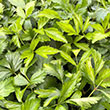
Clean white flowers on wide, feathery plumes. Blooms in early to midsummer. Bright green leaves. USDA 4-9
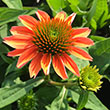
Plant Height: 16 inches
Flower Height: 24 inches
Spread: 18 inches
Sunlight: full sun
Hardiness Zone: 4a
Description:
A stunning first year flowering variety producing a mix of flower colors from rich purple, pink, red-orange, to yellow and white; attracts pollinators and feeds the birds in winter; use in naturalized areas with other native plants
Ornamental Features:
Cheyenne Spirit Coneflower has masses of beautiful lightly-scented orange daisy flowers with red overtones and coppery-bronze eyes at the ends of the stems from mid summer to mid fall, which are most effective when planted in groupings. The flowers are excellent for cutting. Its pointy leaves remain green in color throughout the season.
Landscape Attributes:
Cheyenne Spirit Coneflower is an herbaceous perennial with an upright spreading habit of growth. Its medium texture blends into the garden, but can always be balanced by a couple of finer or coarser plants for an effective composition.
This is a relatively low maintenance plant, and is best cleaned up in early spring before it resumes active growth for the season. It is a good choice for attracting butterflies to your yard, but is not particularly attractive to deer who tend to leave it alone in favor of tastier treats. It has no significant negative characteristics.
Cheyenne Spirit Coneflower is recommended for the following landscape applications:
- Mass Planting
- Rock/Alpine Gardens
- Border Edging
- General Garden Use
- Container Planting
Planting & Growing:
Cheyenne Spirit Coneflower will grow to be about 16 inches tall at maturity extending to 24 inches tall with the flowers, with a spread of 18 inches. Its foliage tends to remain dense right to the ground, not requiring facer plants in front. It grows at a medium rate, and under ideal conditions can be expected to live for approximately 10 years. As an herbaceous perennial, this plant will usually die back to the crown each winter, and will regrow from the base each spring. Be careful not to disturb the crown in late winter when it may not be readily seen!
This plant should only be grown in full sunlight. It is very adaptable to both dry and moist locations, and should do just fine under typical garden conditions. It is considered to be drought-tolerant, and thus makes an ideal choice for a low-water garden or xeriscape application. It is not particular as to soil type or pH. It is highly tolerant of urban pollution and will even thrive in inner city environments. This particular variety is an interspecific hybrid. It can be propagated by division; however, as a cultivated variety, be aware that it may be subject to certain restrictions or prohibitions on propagation.
Cheyenne Spirit Coneflower is a fine choice for the garden, but it is also a good selection for planting in outdoor pots and containers. With its upright habit of growth, it is best suited for use as a 'thriller' in the 'spiller-thriller-filler' container combination; plant it near the center of the pot, surrounded by smaller plants and those that spill over the edges. Note that when growing plants in outdoor containers and baskets, they may require more frequent waterings than they would in the yard or garden.
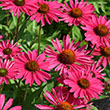
Height: 18 inches
Spread: 24 inches
Sunlight: full sun
Hardiness Zone: 4a
Group/Class: Kismet Series
Description:
Multitudes of glowing, raspberry pink flowers with reddish-gold cones, produced on strong stems; blooms from early summer until frost; use in naturalized areas with other native plants; great for borders
Ornamental Features:
Kismet Raspberry Coneflower has masses of beautiful lightly-scented hot pink daisy flowers with scarlet overtones and gold eyes at the ends of the stems from early summer to mid fall, which are most effective when planted in groupings. The flowers are excellent for cutting. Its pointy leaves remain green in color throughout the season.
Landscape Attributes:
Kismet Raspberry Coneflower is an herbaceous perennial with an upright spreading habit of growth. Its medium texture blends into the garden, but can always be balanced by a couple of finer or coarser plants for an effective composition.
This is a relatively low maintenance plant, and is best cleaned up in early spring before it resumes active growth for the season. It is a good choice for attracting butterflies and hummingbirds to your yard, but is not particularly attractive to deer who tend to leave it alone in favor of tastier treats. It has no significant negative characteristics.
Kismet Raspberry Coneflower is recommended for the following landscape applications:
- Mass Planting
- Rock/Alpine Gardens
- Border Edging
- General Garden Use
- Container Planting
Planting & Growing:
Kismet Raspberry Coneflower will grow to be about 16 inches tall at maturity, with a spread of 24 inches. Its foliage tends to remain dense right to the ground, not requiring facer plants in front. It grows at a fast rate, and under ideal conditions can be expected to live for approximately 10 years. As an herbaceous perennial, this plant will usually die back to the crown each winter, and will regrow from the base each spring. Be careful not to disturb the crown in late winter when it may not be readily seen!
This plant should only be grown in full sunlight. It is very adaptable to both dry and moist locations, and should do just fine under typical garden conditions. It is considered to be drought-tolerant, and thus makes an ideal choice for a low-water garden or xeriscape application. It is not particular as to soil type or pH. It is highly tolerant of urban pollution and will even thrive in inner city environments. This particular variety is an interspecific hybrid. It can be propagated by division; however, as a cultivated variety, be aware that it may be subject to certain restrictions or prohibitions on propagation.
Kismet Raspberry Coneflower is a fine choice for the garden, but it is also a good selection for planting in outdoor pots and containers. It is often used as a 'filler' in the 'spiller-thriller-filler' container combination, providing a mass of flowers against which the larger thriller plants stand out. Note that when growing plants in outdoor containers and baskets, they may require more frequent waterings than they would in the yard or garden.
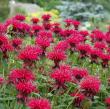
Magenta blooms. Fragrant foliage. Mildew resistant. USDA 4-9
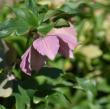
Height: 18 inches
Spacing: 14 inches
Sunlight: partial shade, full shade
Hardiness Zone: 4a
Other Names: Pine Knot Best Strain, Lenten Rose, Winter Rose
Group/Class: Pine Knot Select Mix
Description:
Large nodding buttercup-type single to semi-double blooms are a wide mix of colors, including various shades and tints of white, pink, red, purple, and yellow; great in woodland gardens and on shaded slopes
Ornamental Features:
Pine Knot Select Hellebore features showy nodding rose cup-shaped flowers with purple overtones at the ends of the stems from late winter to early spring. Its glossy oval compound leaves emerge lime green in spring, turning bluish-green in color the rest of the year.
Landscape Attributes:
Pine Knot Select Hellebore is an herbaceous evergreen perennial with an upright spreading habit of growth. Its medium texture blends into the garden, but can always be balanced by a couple of finer or coarser plants for an effective composition.
This is a relatively low maintenance plant, and should be cut back in late fall in preparation for winter. Deer don't particularly care for this plant and will usually leave it alone in favor of tastier treats. It has no significant negative characteristics.
Pine Knot Select Hellebore is recommended for the following landscape applications:
- Mass Planting
- Rock/Alpine Gardens
- Border Edging
- General Garden Use
- Naturalizing And Woodland Gardens
Planting & Growing
Pine Knot Select Hellebore will grow to be about 14 inches tall at maturity, with a spread of 18 inches. When grown in masses or used as a bedding plant, individual plants should be spaced approximately 14 inches apart. Its foliage tends to remain dense right to the ground, not requiring facer plants in front. It grows at a medium rate, and under ideal conditions can be expected to live for approximately 5 years. As an evegreen perennial, this plant will typically keep its form and foliage year-round.
This plant does best in partial shade to shade. It does best in average to evenly moist conditions, but will not tolerate standing water. It is not particular as to soil pH, but grows best in rich soils. It is somewhat tolerant of urban pollution, and will benefit from being planted in a relatively sheltered location. This particular variety is an interspecific hybrid, and parts of it are known to be toxic to humans and animals, so care should be exercised in planting it around children and pets. It can be propagated by division; however, as a cultivated variety, be aware that it may be subject to certain restrictions or prohibitions on propagation.
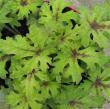
Deeply-lobed, green foliage is accented with dark-purple streaks. White flowers in spring. USDA 4-9
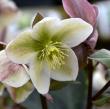
Height: 15 inches
Spacing: 14 inches
Sunlight: partial shade full shade
Hardiness Zone: 4a
Other Names: Lenten Rose, Winter Rose
Description:
Large dangling buttercup-type flowers of ivory streaked with rose and chartreuse emerge in late winter and spring, one of the first flowers to come up in cool weather and what a beautiful harbinger they are; great in woodland gardens and on shaded slopes
Ornamental Features:
Ivory Prince Hellebore features showy nodding white cup-shaped flowers with chartreuse overtones and rose streaks at the ends of the stems from late winter to early spring. Its glossy oval compound leaves remain bluish-green in color throughout the year.
Landscape Attributes:
Ivory Prince Hellebore is an herbaceous evergreen perennial with an upright spreading habit of growth. Its medium texture blends into the garden, but can always be balanced by a couple of finer or coarser plants for an effective composition.
This is a relatively low maintenance plant, and should be cut back in late fall in preparation for winter. Deer don't particularly care for this plant and will usually leave it alone in favor of tastier treats. It has no significant negative characteristics.
Ivory Prince Hellebore is recommended for the following landscape applications:
- Mass Planting
- Rock/Alpine Gardens
- Border Edging
- General Garden Use
- Naturalizing And Woodland Gardens
Planting & Growing:
Ivory Prince Hellebore will grow to be about 12 inches tall at maturity, with a spread of 18 inches. When grown in masses or used as a bedding plant, individual plants should be spaced approximately 14 inches apart. Its foliage tends to remain dense right to the ground, not requiring facer plants in front. It grows at a medium rate, and under ideal conditions can be expected to live for approximately 5 years. As an evegreen perennial, this plant will typically keep its form and foliage year-round.
This plant does best in partial shade to shade. It does best in average to evenly moist conditions, but will not tolerate standing water. It is not particular as to soil pH, but grows best in rich soils. It is somewhat tolerant of urban pollution, and will benefit from being planted in a relatively sheltered location. This particular variety is an interspecific hybrid, and parts of it are known to be toxic to humans and animals, so care should be exercised in planting it around children and pets. It can be propagated by division; however, as a cultivated variety, be aware that it may be subject to certain restrictions or prohibitions on propagation.

Ivory rose outward facing blooms. Glossy foliage. USDA 5-8
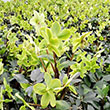
White flowers are tinged with lime-green accents. Rabbit and deer resistant. Semi-evergreen. USDA 6-9
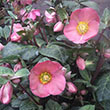
Penny's Pink' Hellebore | Muave outward-facing blooms. Marbled evergreen foliage. USDA 4-9
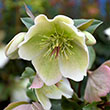
Molly's White Hellebore | White, single-petaled flowers with lime-green accents. Late season bloomer. USDA 4-8
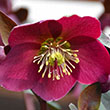
'Anna's Red' Hellebore | Burgundy outward facing blooms. Marbled foliage. Evergreen. USDA 4-9
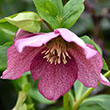
Blooms in purple, red, pink, green, & white. Evergreen. USDA 4-9
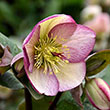
Plant Height: 18 inches
Flower Height: 24 inches
Spacing: 16 inches
Sunlight: partial shade full shade
Hardiness Zone: 4b
Other Names: Lenten Rose, Winter Rose
Group/Class: Frostkiss Series
Description:
This beautiful selection produces bushy mounds of thick evergreen leaves; flower stalks, held above the foliage bear showy, cup shaped, creamy white blooms with violet edges and butter yellow anthers; a great selection for shade gardens
Ornamental Features:
Frostkiss Glenda's Gloss Hellebore features showy nodding creamy white cup-shaped flowers with buttery yellow eyes and violet edges at the ends of the stems from late winter to mid spring. Its attractive serrated oval compound leaves emerge chartreuse in spring, turning dark green in color with distinctive grayish green veins the rest of the year.
Landscape Attributes:
Frostkiss Glenda's Gloss Hellebore is an herbaceous evergreen perennial with an upright spreading habit of growth. Its medium texture blends into the garden, but can always be balanced by a couple of finer or coarser plants for an effective composition.
This is a relatively low maintenance plant, and should be cut back in late fall in preparation for winter. Deer don't particularly care for this plant and will usually leave it alone in favor of tastier treats. It has no significant negative characteristics.
Frostkiss: Glenda's Gloss Hellebore is recommended for the following landscape applications:
- Mass Planting
- Rock/Alpine Gardens
- Border Edging
- General Garden Use
- Naturalizing And Woodland Gardens
Planting & Growing:
Frostkiss Glenda's Gloss Hellebore will grow to be about 18 inches tall at maturity extending to 24 inches tall with the flowers, with a spread of 20 inches. When grown in masses or used as a bedding plant, individual plants should be spaced approximately 16 inches apart. Its foliage tends to remain dense right to the ground, not requiring facer plants in front. It grows at a medium rate, and under ideal conditions can be expected to live for approximately 5 years. As an evegreen perennial, this plant will typically keep its form and foliage year-round.
This plant does best in partial shade to shade. It does best in average to evenly moist conditions, but will not tolerate standing water. It is not particular as to soil pH, but grows best in rich soils. It is somewhat tolerant of urban pollution, and will benefit from being planted in a relatively sheltered location. This particular variety is an interspecific hybrid, and parts of it are known to be toxic to humans and animals, so care should be exercised in planting it around children and pets. It can be propagated by division; however, as a cultivated variety, be aware that it may be subject to certain restrictions or prohibitions on propagation.
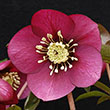
Deep, magenta flowers bloom on rich-green stalks. Mounding. USDA 3-9
19 found, showing page 1 of 2










